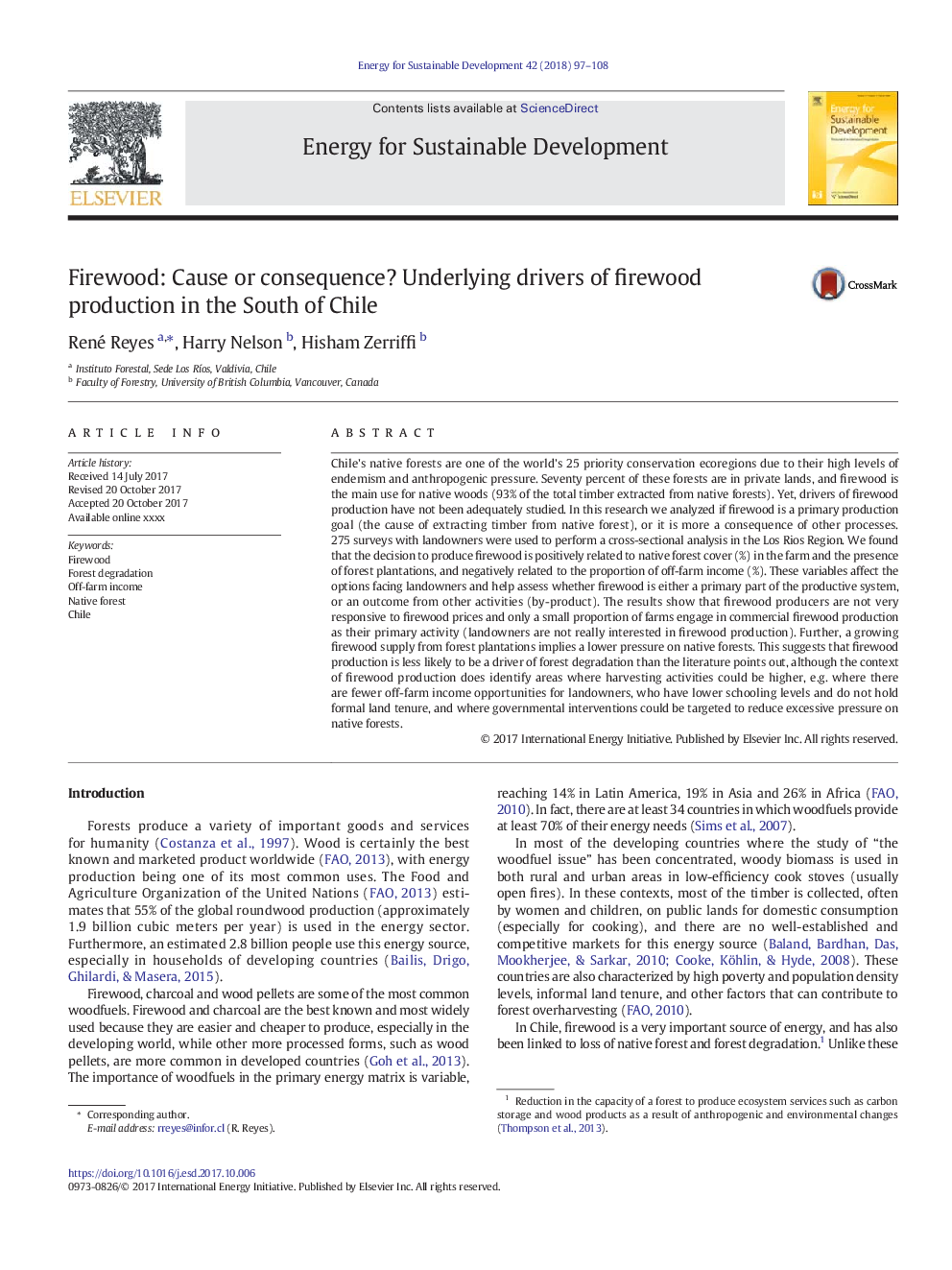| کد مقاله | کد نشریه | سال انتشار | مقاله انگلیسی | نسخه تمام متن |
|---|---|---|---|---|
| 7453702 | 1484388 | 2018 | 12 صفحه PDF | دانلود رایگان |
عنوان انگلیسی مقاله ISI
Firewood: Cause or consequence? Underlying drivers of firewood production in the South of Chile
ترجمه فارسی عنوان
هیزم: علت یا پیامد رانندگان اصلی تولید چوب در جنوب شیلی
دانلود مقاله + سفارش ترجمه
دانلود مقاله ISI انگلیسی
رایگان برای ایرانیان
کلمات کلیدی
هیزم، تخریب جنگل، درآمد مزرعه، جنگل بومی، شیلی،
ترجمه چکیده
جنگل های بومی شیلی یکی از 25 اکواریوم حفاظت از اولویت جهان به علت سطوح بالایی اندمیزی و فشار انسانی هستند. هفتاد درصد این جنگل ها در سرزمین های خصوصی قرار دارند و هیزم اصلی استفاده از جنگل های بومی (93٪ کل چوب از جنگل های بومی) است. با این حال، رانندگان تولید هیزم به اندازه کافی مورد مطالعه قرار نگرفته اند. در این تحقیق، اگر هیزم یک هدف اصلی تولید (علت استخراج چوب از جنگل بومی) باشد، آن را تحلیل کردیم یا بیشتر از سایر فرایندها است. 275 نظرسنجی با مالکان زمین برای انجام تجزیه و تحلیل مقطعی در منطقه لس ریو مورد استفاده قرار گرفت. ما دریافتیم که تصمیم گیری برای تولید هیزم به طور مثبت با پوشش جنگلی بومی (٪) در مزرعه و حضور گیاهان جنگلی و منفی مربوط به نسبت درآمد خارج از مزرعه (٪) مثبت است. این متغیرها بر گزینه هایی که صاحب مالکان می شود را تحت تاثیر قرار می دهد و کمک می کند تا ارزیابی کند که آیا هیزم یا بخش اصلی سیستم مولد است یا نتیجه فعالیت های دیگر (محصول جانبی). نتایج نشان می دهد که تولید کنندگان هیزم به قیمت های هیزم پاسخگو نیستند و تنها بخش کوچکی از مزارع به عنوان فعالیت اصلی خود در تولید هیزم تجاری فعالیت می کنند (مالکان واقعا علاقه مند به تولید هیزم نیستند). علاوه بر این، افزایش تولید هیزم از گیاهان جنگلی به فشارهای پایین در جنگل های بومی منجر می شود. این نشان می دهد که تولید هیزم به عنوان یک راننده از تخریب جنگل کمتر از ادبیات است، هرچند که زمینه تولید هیزم مناطق را مشخص می کند که فعالیت های برداشت می تواند بیشتر باشد، به عنوان مثال جایی که فرصت های کمتری برای درآمد مزرعه دار برای صاحبخانه ها وجود دارد که دارای سطوح پایین تحصیل هستند و مالکیت رسمی زمین را ندارند و در صورتی که مداخلات دولت برای کاهش فشار بیش از حد بر روی جنگل های بومی هدف قرار گیرد.
موضوعات مرتبط
مهندسی و علوم پایه
مهندسی انرژی
انرژی (عمومی)
چکیده انگلیسی
Chile's native forests are one of the world's 25 priority conservation ecoregions due to their high levels of endemism and anthropogenic pressure. Seventy percent of these forests are in private lands, and firewood is the main use for native woods (93% of the total timber extracted from native forests). Yet, drivers of firewood production have not been adequately studied. In this research we analyzed if firewood is a primary production goal (the cause of extracting timber from native forest), or it is more a consequence of other processes. 275 surveys with landowners were used to perform a cross-sectional analysis in the Los Rios Region. We found that the decision to produce firewood is positively related to native forest cover (%) in the farm and the presence of forest plantations, and negatively related to the proportion of off-farm income (%). These variables affect the options facing landowners and help assess whether firewood is either a primary part of the productive system, or an outcome from other activities (by-product). The results show that firewood producers are not very responsive to firewood prices and only a small proportion of farms engage in commercial firewood production as their primary activity (landowners are not really interested in firewood production). Further, a growing firewood supply from forest plantations implies a lower pressure on native forests. This suggests that firewood production is less likely to be a driver of forest degradation than the literature points out, although the context of firewood production does identify areas where harvesting activities could be higher, e.g. where there are fewer off-farm income opportunities for landowners, who have lower schooling levels and do not hold formal land tenure, and where governmental interventions could be targeted to reduce excessive pressure on native forests.
ناشر
Database: Elsevier - ScienceDirect (ساینس دایرکت)
Journal: Energy for Sustainable Development - Volume 42, February 2018, Pages 97-108
Journal: Energy for Sustainable Development - Volume 42, February 2018, Pages 97-108
نویسندگان
René Reyes, Harry Nelson, Hisham Zerriffi,
